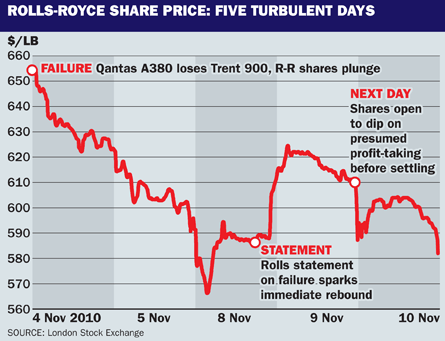Rolls-Royce shares enjoyed a long summer and autumn run on the London Stock Exchange to a 52-week high of 661.5p on 1 November and closing at 654.5p ($10.65) on Wednesday the 3rd. Then, London woke on the 4th to the news that a Trent 900 engine had blown up on the wing of a Qantas Airbus A380 departing Singapore. The aircraft maintained altitude for a safe return to Changi, but Rolls-Royce shares went into freefall.
By the bell on Thursday, R-R was down 5% at 621p. On Friday another 5% evaporated. The weekend offered more bad news - a 747, again Qantas, again R-R-powered - had suffered engine failure. Trading opened at 577.5p and carried right on down to 563p, by which point R-R had seen its shares plummet 14%, wiping nearly £1.75 billion ($2.8 billion) off its market value.
Whatever is ultimately determined to be the cause of the Trent 900 failure, R-R is entitled to feel unlucky. Uncontained engine failures are relatively rare, but they do happen. This one, unfortunately, happened to an example of the world's newest and biggest passenger aircraft. The subsequent 747 failure involved a totally different R-R engine, yet traders seemed to take downward momentum from that second incident. As one analyst puts it, shares would have been expected to dip on the news, but the market reaction to the whole affair looked "overdone".
 |
|---|
What is clear, though, is that R-R was getting hammered not for the loss of a couple of engines but for its reaction - or more precisely, lack of reaction - to the incidents. A brief statement on Thursday morning acknowledged the Trent 900 failure but did little to allay concerns: "We have been working closely with our customer and the authorities. In situations like these Rolls-Royce has well established processes to collect and understand information relating to the event and to determine suitable actions."
R-R engineers were no doubt working round the clock to figure out what happened under that Qantas wing, but the company's public presence amounted to five days of silence. Meanwhile, talk in the industry involved lots of speculation and one firmly-held certainty: "This is just what you expect from R-R - silence."
SILENCE IS LEADEN
Professor Joseph Lampel of City University London's Cass Business School says that up until Monday mid-afternoon R-R was doing almost everything wrong to manage what was rapidly threatening to become a public relations disaster. When faced with uncertainty, Professor Lampel notes, people naturally - though not necessarily rationally - start to create patterns between seemingly related incidents. In this case, the Trent 900 failure started to look connected to the Boeing 787 Trent 1000 test bed failure at Derby in August, and even to three Qantas 747 engine failures (one contained and one hydraulic following the Trent 900 explosion, and an uncontained failure in September while operating from San Francisco).
Critically, he says, it's necessary to act quickly to break those patterns. But while R-R should have moved to assure people that the Trent failure was an isolated incident, it remained silent.
Then, says Lampel, the company made the mistake of treating the problem as purely technical. Again, to remain silent is effectively to put faith in the notion that the "facts will speak for themselves". While that's true in the long term, it's very much not true in the short term, he says.
R-R faced a dilemma, as its reputation for engineering excellence was being undermined by a string of technical problems, but that reputation also wouldn't be helped by making statements not well-supported by facts. Sources indicate the company opted to stay quiet rather than be seen entering into speculation itself.
Ultimately, R-R itself proved the value of information with a second statement. At 15:52 GMT last Monday it announced that the A380 failure was clearly "specific to the Trent 900" and "we can be certain that the separate Trent 1000 event which occurred in August 2010 on a test bed in Derby is unconnected".
That left many questions unanswered, but the market clearly liked what it heard. Two minutes later, R-R shares rocketed.
Source: Flight International























